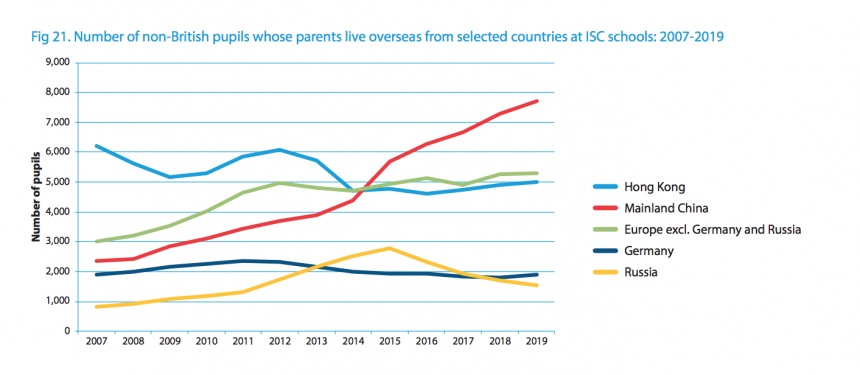British independent schools have recorded an increase in the number of pupils from European Economic Area countries despite ongoing Brexit uncertainty, data from the Independent Schools Council has revealed.
News and business analysis for Professionals in International Education
Have some pie!
EEA pupils at UK independent schools up despite Brexit uncertainty
 Numbers from the EEA were shown to have been increasing since 2017 after a period of decline from 2012. Image: ISC
Numbers from the EEA were shown to have been increasing since 2017 after a period of decline from 2012. Image: ISC According to its annual census the body, which represents more than 1,300 UK independent schools, revealed there are currently 26,370 non-British pupils in ISC schools whose parents live in the UK.
“There are more pupils being educated in overseas campuses than there are overseas pupils in ISC schools”
This cohort made up 5% of all pupils at ISC schools, up slightly from 2018’s 25,165 students.
However, among these pupils, 45% came from EEA countries – up three points from last year – which “is an interesting finding in light of Brexit,” the census noted.
Additionally, the census showed there are currently 28,910 non-British pupils attending ISC schools whose parents live overseas, making up 5.4% of the total ISC pupil population.
Among non-British pupils whose parents live overseas, the census showed steady growth in pupil numbers from China (up 6% on 2018), while among pupils from Russia, it highlighted four years of decline after a period of steady growth (down 10%).
“Non-British pupil numbers from Hong Kong have been growing since 2016, although have not yet returned to historical highs”, noted the census.
Meanwhile, numbers from the EEA were shown to been increasing since 2017 after a period of decline from 2012.
“It is perhaps surprising to see an increase in the number of EEA pupils at ISC schools given the uncertainty surrounding Brexit,” said ISC chairman Barnaby Lenon in a statement.
“But clearly much value is placed on the broad all-round education independent schools offer [including] their inclusive environments and commitment to supporting the development of globally conscious young people.”
And while most independent schools are small schools serving their local community, added Lenon, “some attract pupils of many different nationalities and these young people have a positive influence on our ability to understand other cultures as well as the country’s economy and our intellectual base”.
As revealed by Oxford Economics in a 2018 impact report, non-British pupils at ISC schools contribute £1.8billion to GDP in the UK, support 39,310 jobs and generating £550m in annual tax revenue.
“It is perhaps surprising to see an increase in the number of EEA pupils”
The census also showed that a growing number of ISC schools are operating overseas campuses, educating a total of 39,616 pupils compared to the 28,910 pupils whose parents live overseas.
According to the data, there are currently 58 such campuses educating a total of 39,616 pupils, up from 47 campuses and 32,330 pupils in 2018.
“There are, therefore, more pupils being educated in overseas campuses than there are overseas pupils in ISC schools in the UK,” noted the census.
Of those campuses, mainland China has the highest number with 26 campuses, educating a total of 15,137 pupils, followed by the Middle East (13), Thailand (5) and Hong Kong (4).
South Korea and Malaysia were shown to have two such campuses respectively.
Earlier in 2019, third-party research firm ISC Research highlighted the growth of “an international style of education” in China, with reasons such as the rise in private education expenditure among Chinese families, Beijing’s amended “two-child” policy, and increased awareness of the benefits of international education suggested for the boom.
The US was revealed to be the most popular destination for higher education outside of the UK
With regards to higher education, the census revealed that of those continuing to higher education, 93% do so within the UK.
For the 5% of pupils that chose to study outside of the UK, the US was revealed to be the most popular destination attracting almost half (47.5%) of ISC pupils going to overseas universities.
However, this is down on last year when over 50% chose to study in the US, it noted.
Still looking? Find by category:


